Florence, Namsal Siedlecki's solo exhibition at Museo Novecento featuring his research on materials
Young Italian-U.S. artist Namsal Siedlecki (Greenfield, 1986) is the protagonist of a solo exhibition at the Museo Novecento in Florence, where Siedlecki will be on view from Oct. 5, 2023, to April 3, 2024, in the cloister spaces, with four sculptural groups made for the Renaissance courtyard of the former Leopoldine. The exhibition is titled Endo, is curated by Sergio Risaliti and Stefania Rispoli, and aims to highlight the artist’s longstanding research into the processual and transformative nature of materials.
The exhibition, part of the calendar of initiatives of Florence Art Week 2023, stems from references ranging from alchemy to chemistry, from robotics to anatomy, from a fascination with “celibate machines” to the plastics of 20th-century masters, and takes its title from the Greek word á¼”νδον, which in scientific and medical circles defines that which is “inside” or “located within”; in fact, it is no coincidence that the artist has chosen to exhibit within what can be considered the belly of the museum, the cloister, the central environment once deputed to reflection, reading and meditation. In this belly, metaphorically interpreted as a stomach, the artist exhibits sculptures in close dialogue with each other, conceived as a single large installation in which matter disintegrates and is transformed, creating energy: four stomachs that, when put into operation, act as a single body, ideally distilling segments of imagination.
The first sculptural group, Still, is a wrought copper still with monumental dimensions: a work designed by the artist and made by one of the last Italian artisans specializing in the production of these objects. Traditionally, the still consists of a belly that contains the element to be distilled, a head into which the vapors flow, and a cooling coil that collects the distilled product. The sculpture thus unites, in a single body, all the passing states of matter: solid, liquid and gaseous.
“Alchemists used to associate the still with the functions of the human body,” says Namsal Siedlecki. “This association referred more properly to the act of digestion, which is when, by assimilating energy through the introduction and transformation of solid matter within our bodies, we actually distill reality. We use what nature offers us by purifying it, just as the still extracts the essence of matter and in a sense perfects and concentrates it.” During the course of the exhibition, Still will periodically go into operation producing a distillate that is the result of active public participation. Inside its “stomach” will be placed and distilled the drawings made by those who wish to try their hand at live drawing sessions, portraying the works on display because, as the artist states, “Drawing is in fact the distillate of a glance.” The liquid produced will fill the terracotta sculptures part of the installation.
The second sculpture housed in the courtyard is Fago (Ugolino), made of sulfur, a material that melts at a low temperature into a red liquid similar to blood, and a founding element of alchemy, laden with history, meaning and symbolism that often associates it with the world of the Underworld. The sculpture inspired by a 1904 work by Auguste Rodin depicting the Pisan nobleman murderer and cannibal of his own children, whose misadventures are narrated by Dante, was made using a 3D printer that recreated a copy of the work divided into eight portions. A sulfur copy was made of each, with the idea of returning each sacrificed son to the future through an element related to the idea of digestion, transformation and putrefaction.
The third sculptural group, Vaso (Moore), made of terracotta, was born from a collaboration with the Opificio delle Pietre Dure and is inspired by the restoration of Guerriero, a sculpture by Henry Moore donated to the city of Florence in the 1970s and exhibited for a long time in the cloister of the basilica complex of Santa Croce. In the course of the restoration, several small irons and metal objects were found that had been hidden inside for years in a state of slow but continuous transformation, forms in the making waiting to be released. These small abstract sculptures molded in the belly of another work were scanned in 3-D, enlarged and made in terracotta, becoming containers ready to receive a distillate: from forms contained in another body to containers of another form, a liquid that, more than any other element, experiences a constant transformation by adapting to the space that contains it.
The fourth element is a biogas production device, a large container that, by culturing microorganisms in a chemical process that can be associated with that of a still or animal digestion, is able to turn waste into gas. The Israeli start-up that produces this tank often calls it a stomach. In a circular motion, the gas produced during the course of the exhibition will be used to fuel the flame of the Still still putting it into operation.
Endo thus wants to tell the story of digestion in its alchemical interpretation as a process fueled by an internal heat of spiritual origin that brings food to perfection, separates pure from impure components, and generates nourishment, and at the same time tells of experimentation, the alchemical imitation of nature in an attempt to act on matter.
Pictured are the four works on display at the Endo exhibition. Photo: Michele Alberto Sereni
 |
| Florence, Namsal Siedlecki's solo exhibition at Museo Novecento featuring his research on materials |
Warning: the translation into English of the original Italian article was created using automatic tools. We undertake to review all articles, but we do not guarantee the total absence of inaccuracies in the translation due to the program. You can find the original by clicking on the ITA button. If you find any mistake,please contact us.




























